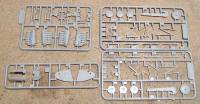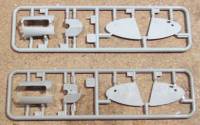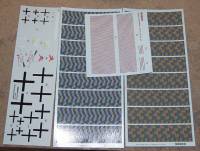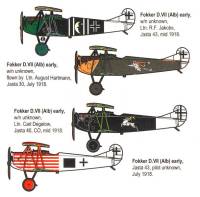Roden 1/48th Fokker D.VII Albatros-built "early"
|
 |
History- well, actually not!
As with the history of the P-51, B-17, F-16, etc., etc., you can do
a Google search and you will get pages of electronic information on how
the D-VII came to be, so let's concentrate on some details and production
facts.
Fokker D-VII - read the name and think what comes to mind. The BEST
fighter produced by Fokker, or anyone some will argue, during the First
World War. The only aircraft specifically mentioned for destruction or
surrender in the terms of the armistice for The Great War. However, few
people realize that when you are talking about the D-VII you are talking
about at least six  different
types of aircraft. Those six versions are the Fokker-built D-VII early
versions, and the improved Fokker D-VIIf, late war aircraft. The Ostdeutsche
Albatros-Werke, OAW (East German Albatros Works at Schneidemuhl) built
Fokker D-VII OAW both early and late versions, and the Albatros (at Johannisthal)
built Fokker D-VII Alb, also early-and late-war variants. Mind you that
to the unaided eye, they all look the same. But to us rivet, or in this
case louver and stitch counters, there are noticeable differences. different
types of aircraft. Those six versions are the Fokker-built D-VII early
versions, and the improved Fokker D-VIIf, late war aircraft. The Ostdeutsche
Albatros-Werke, OAW (East German Albatros Works at Schneidemuhl) built
Fokker D-VII OAW both early and late versions, and the Albatros (at Johannisthal)
built Fokker D-VII Alb, also early-and late-war variants. Mind you that
to the unaided eye, they all look the same. But to us rivet, or in this
case louver and stitch counters, there are noticeable differences.
The main noticeable difference is the configuration of the side cowlings
around the engines. Early cowlings were relatively smooth. Later versions
had multiple configurations of cooling louvers that were added to the
engine cowling by the manufacturers and by the troops in the field because
a series of in-flight fires caused by the ammunition boxes over heating
and the rounds inside cooking off. In addition to cooling vents, OAW and
Albatros each added variations in access doors in the cowling. A good
illustrated summary of these changes can be found in the Squadron Signal
"In Action" booklet on the D-VII and in the Albatros Publications
"Fokker Anthologies".
In addition to the cowling differences there are minor differences in
the attachment and width of the axle fairing, which one of three different
types of engines are installed, or what type of propeller is used.
Lastly, my research for this article indicated that the machine guns
have been installed at one of three different heights above the cowling.
These changes were made to minimize sonic damage from the bullets on the
engine and its accessories, and to accommodate the larger BMW engine.
As an aerospace engineer, I am fascinated with engineering and production
details. The D-VII is an example of what lengths a losing military nation
can achieve if it must. It is paramount to keep in mind the timeframe
we are discussing. The D-type fighter competition that spawned this airplane
was held in January 1918. Hostilities in the Great War ceased, in essence,
nine months later in November. The final accurate number is not known,
but between these two dates, these three factories turned out approximately
2,000 D-VII airplanes! Allowing for tooling and production ramp up time,
which  allowed
first deliveries in March 1918 that works out to better than EIGHT airplanes
a day, from a country that was in essence defeated, and out of resources!
(Note: my multiple references put the final production number of D-VIIs
above 1,000, probably closer to 1,700, but definitely not more than 2,000. allowed
first deliveries in March 1918 that works out to better than EIGHT airplanes
a day, from a country that was in essence defeated, and out of resources!
(Note: my multiple references put the final production number of D-VIIs
above 1,000, probably closer to 1,700, but definitely not more than 2,000.
The Roden instructions state that the Albatros Werke alone produced
2,600 airplanes, which was 55% of all D-VII production. This implies that
total production ranges totaled almost 4,700 aircraft. I cannot find any
source that confirms this higher final production number.) The fascinating
fact is that in HALF of this short time, the folks at Fokker had to not
only produce the aircraft for which they contracted, but they also had
to reproduce and deliver every production drawing for the D-VII aircraft
and production tooling, at least twice, and by hand. Only then could OAW
and Albatros could tool up and also go into production.
Finally keep in mind that the first aircraft arrived in the field in
late March, just two months after the Adlershof competition. And OAW and
Albatros had started production in the early configuration of the Fokker
design. This is evidenced by the fact that early aircraft produced by
either of these two companies had additional cooling louvers in the cowling.
As for the subject of this kit, you have to give credit to the national
pride of the Albatros Werke. First they lose the big competition to a
Dutchman – posing as a German, and then they are forced to build
his airplane. But they got even and improved Fokker's design by adding
access panels and making the axle fairing much easier to remove. Lastly,
to top it off, Albatros-Werke produced more Fokker D-VIIs than Fokker
did!
Sorry a Soapbox Rant
 NO
the "D" in D-VII DOES NOT stand for "Doppeldeker"
or biplane, it stands for Type D, or D Class aircraft: a single seat armed
scout over 150 horsepower. FMI: see https://www.wwi-models.org/misc/desig.html.
And…them wings ain't flat! NO
the "D" in D-VII DOES NOT stand for "Doppeldeker"
or biplane, it stands for Type D, or D Class aircraft: a single seat armed
scout over 150 horsepower. FMI: see https://www.wwi-models.org/misc/desig.html.
And…them wings ain't flat!
Researching this review finally answered a question I've had for a
decade or so. It is the general consensus that the D-VIIs wings taper
in thickness, but not in chord, from wing root to wingtip. This assumption
would conclude that the angle caused by this tapering is offset by the
wing spars so that the top of the wing appears to be flat from tip to
tip, and the bottom of the wing appears to have some dihedral from sloping
upward from root to tip. The Joseph Nieto drawings from Air Age Publications
show one degree of anhedral in the upper surface of the upper wing and
two degrees of dihedral in the lower surface of the same wing. These numbers
are 35 minutes of anhedral and 1 degree 20 minutes dihedral for the lower
wing.
The Kit
For decades modelers who like 1/48 scale had to be content to build
one kit of the Fokker D-VII. That kit came from the 1950's vintage molds
by Aurora. That model was and still is slightly off scale, the wings are
too big, the fuselage is very slightly too long, but with respect to the
wing the fuselage is too thin, but this makes it just right for 1/48.
These molds found their way to being re-popped by Merritt, K&B, Monogram,
and currently by RoG. Then, 20 years ago, (yep…that long folks) DML
issued what became the new standard in WW-I modeling. It had its slight
dimensional flaws and it was a bit fiddly to build, but it was better
than the Aurora versions and it was a NEW 1/48th WW-I topic! With the
fall of communism in Eastern Europe, the modeling world has been given
a bounty of new ACCURATE WW-I kits from Roden, Eduard, Flashback and Gavia.
 The
subject of this review is Roden's kit # 421 a 1/48 rendition of the Fokker
D-VII Alb (early). This follows on the heels of kit #415 the Fokker D-VII,
early version, #417 the Fokker D-VIIf, and #420 the Fokker D-VII OAW (early).
Still in the works at Roden are kit #418 the Fokker D-VII OAW (mid) and
kit #424 the Fokker D-VII Alb (late). The
subject of this review is Roden's kit # 421 a 1/48 rendition of the Fokker
D-VII Alb (early). This follows on the heels of kit #415 the Fokker D-VII,
early version, #417 the Fokker D-VIIf, and #420 the Fokker D-VII OAW (early).
Still in the works at Roden are kit #418 the Fokker D-VII OAW (mid) and
kit #424 the Fokker D-VII Alb (late).
As with the rest of this line, the kit comes with five "common"
D-VII sprues, and a unique sprue "H" containing the engine cowling
that is unique to the early Albatros built D-VIIs. Shown in one of the
pictures is a comparison of the early Fokker D-VII cowl (upper) and the
new cowling that comes in this kit (lower). This kit came in Roden's faded
OD green plastic. Decals are provided for four relatively colorful aircraft,
complete with upper and lower lozenge and lavender rib tapes. The four
aircraft are Ltn. August Hartmann's OD and yellow aircraft with a witch
riding a broom on the sides; a red and white striped aircraft from Jasta
43; Ltn. RF Jakobs' green black and white aircraft with a quarter-moon
on the side; and the box art black and aircraft of Ltn. Carl Degelow,
featuring a large white stag on the sides.
Complimenting Roden, they listened and responded to reviews (and often
too harsh critiques) of their kits. In this case earlier reviewers had
difficulty stuffing all of the engine mounts around the engines, and adding
the cowlings. It resulted in cowlings that stuck out wider than the rest
of the fuselage. In this edition Roden does a little better job of indicating
that the assemblies in Step 9 produce the option of an open engine with
the side and top cowlings off, and the option in Step 10 produces the
option of an engine with the entire cowling on. The kit also comes with
a choice of propellers and axle fairings, the instructions also clearly
point out which of these options are to be used for which choice of markings.
 As
far as accuracy goes, when laid out on the five views in Albatros Publications
"Fokker Anthology #3", the fuselage is ever so slightly longer
from the cockpit opening to the tail post, and there is some minor mismatch
between the upper wing and the drawing. If you center the cockpit cutout
opening on the wing with the drawing, then the wing is shifted towards
the left tip. If you align the shipping bumpers on the leading edge with
the drawing, the tips come out correct, but the cockpit cutout is now
shifted ever so slightly to the right. In either case it is far more accurate
than the Aurora/Monogram/new RoG offerings, and it may be a flaw in the
reproduction of the drawings in the book and not the model's parts. I
cannot comment on the DML kit. I sold off my only copy just before the
Roden kits started appearing, for a mega profit. As
far as accuracy goes, when laid out on the five views in Albatros Publications
"Fokker Anthology #3", the fuselage is ever so slightly longer
from the cockpit opening to the tail post, and there is some minor mismatch
between the upper wing and the drawing. If you center the cockpit cutout
opening on the wing with the drawing, then the wing is shifted towards
the left tip. If you align the shipping bumpers on the leading edge with
the drawing, the tips come out correct, but the cockpit cutout is now
shifted ever so slightly to the right. In either case it is far more accurate
than the Aurora/Monogram/new RoG offerings, and it may be a flaw in the
reproduction of the drawings in the book and not the model's parts. I
cannot comment on the DML kit. I sold off my only copy just before the
Roden kits started appearing, for a mega profit.
Conclusion
I'm looking forward to assembling this kit so you can see the results
as it comes out of the box.
Thanks to Roden for supplying
the kit for review.
|
|
